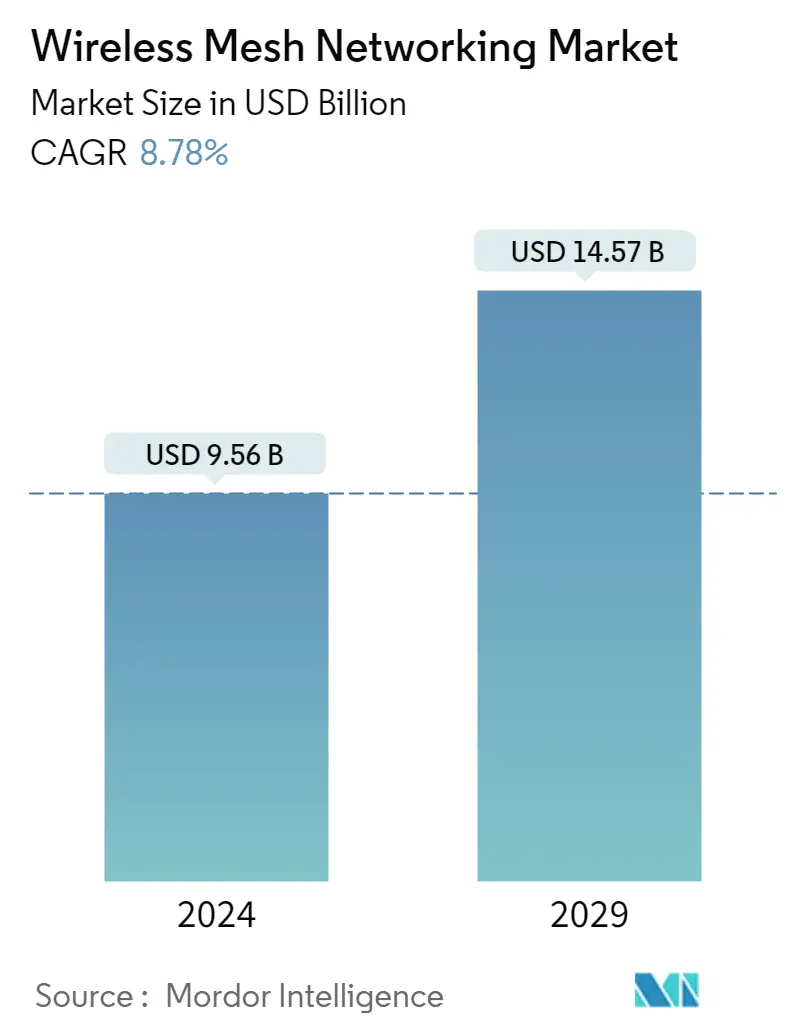Market Size of Wireless Mesh Networking Industry

| Study Period | 2019 - 2029 |
| Market Size (2024) | USD 9.56 Billion |
| Market Size (2029) | USD 14.57 Billion |
| CAGR (2024 - 2029) | 8.78 % |
| Fastest Growing Market | Asia Pacific |
| Largest Market | North America |
Major Players
*Disclaimer: Major Players sorted in no particular order |
Wireless Mesh Networking Market Analysis
The Wireless Mesh Networking Market size is estimated at USD 9.56 billion in 2024, and is expected to reach USD 14.57 billion by 2029, growing at a CAGR of 8.78% during the forecast period (2024-2029).
The global wireless mesh networking (WMN) market is expected to experience significant expansion during the forecast period, owing to advancements in the wireless communication sector. The deployment of this technology is being driven by major advantages such as resilient communications, low financial cost, and flexible scale.
- Another advantage of these networks is their auto-configuration and self-organization capability, which allows them to enhance coverage, capacity, and availability by deploying more WAPs without disturbing other nodes. This makes them easy to expand and suitable for various applications.
- In July 2023, Rajant Corporation, one of the leading global pioneers of Kinetic Mesh wireless networks headquartered in Malvern, Pennsylvania, entered a strategic distribution agreement with Crossover Distribution last year. Crossover is one of the leading wireless solutions providers skilled in design and engineering expertise to support North America. Their agreement represents Rajant's further global investment to introduce its global-leading Kinetic Mesh solution to Crossover's customers within industries such as mining, indoor automation, smart cities, public safety, and rural broadband.
- The wireless mesh networking market is experiencing significant growth due to increasing adoption of IoT and industrial automation across all sectors. Innovations in this technology are creating new applications in various markets, including the fixed wireless market.
- Wireless mesh networking (WMN) is also ideal for tracking pallets and monitoring large physical objects with a highly reliable wireless connectivity network due to its connectivity advantage and low cost. This technology can easily track key data across the factory floor and multiple locations to identify issues before they occur, attracting many vendors to offer industry-oriented products.
- With growing automation in the agriculture sector, WMN technology is also excellent for tracking sun exposure and water levels in crops. It can be scaled at a low cost with mesh-enabled nodes across an entire land, to develop a cellular connected IoT farm.
Wireless Mesh Networking Industry Segmentation
A wireless mesh network is a communications network made up of radio nodes organized in a mesh topology. It is also a form of wireless ad hoc network. A mesh refers to rich interconnection among devices or nodes. Wireless mesh networks often consist of mesh clients, mesh routers, and gateways. In terms of architecture, a wireless mesh network is being segregated as Infrastructure wireless mesh networks, hybrid wireless mesh networks, and client wireless mesh networks.
The wireless mesh networking market is segmented by architecture (infrastructure wireless mesh networks, hybrid wireless mesh networks, and client wireless mesh networks), application (indoor and outdoor), and geography (North America, Europe, Asia Pacific, Latin America, and Middle East and Africa). The report offers market forecasts and size in value (USD) for all the above segments.
| By Architecture | |
| Infrastructure Wireless Mesh Networks | |
| Hybrid Wireless Mesh Networks | |
| Client Wireless Mesh Networks |
| By Application | |
| Indoor | |
| Outdoor |
| Geography | ||||||
| ||||||
| ||||||
| ||||||
| Rest of The World |
Wireless Mesh Networking Market Size Summary
The wireless mesh networking market is poised for substantial growth, driven by advancements in wireless communication technologies and the increasing adoption of IoT and industrial automation across various sectors. This market is characterized by its ability to provide resilient communications, cost-effectiveness, and flexible scalability, making it suitable for diverse applications. The technology's auto-configuration and self-organization capabilities enhance coverage and capacity, allowing for easy expansion without disrupting existing nodes. Strategic partnerships, such as Rajant Corporation's agreement with Crossover Distribution, highlight the global investment in introducing advanced mesh solutions across industries like mining, smart cities, and rural broadband. The market's expansion is further supported by innovations that create new applications, such as tracking and monitoring in agriculture and industrial settings, underscoring the technology's versatility and connectivity advantages.
In North America, the wireless mesh networking market is the largest globally, with significant growth driven by the demand for security surveillance and mission-critical applications. The region has seen a surge in new product launches and strategic mergers and acquisitions. The United Kingdom is also experiencing increased adoption in sectors like oil and gas and chemicals, fueled by government initiatives to establish municipal wireless networks. The market is semi-consolidated, with key players like ABB, Cisco, and HP leading the charge. Recent developments include the introduction of Wi-Fi 6-enabled devices and advanced mesh systems, which enhance home and industrial networking capabilities. These innovations reflect the market's ongoing evolution and the growing need for high-speed, reliable connectivity solutions.
Wireless Mesh Networking Market Size - Table of Contents
-
1. MARKET DYNAMICS
-
1.1 Market Overview
-
1.2 Introduction to Market Drivers and Restraints
-
1.3 Market Drivers
-
1.3.1 Cost-Effectiveness And The Flexibility To Expand Effortlessly
-
1.3.2 Reliability Owing To Multi-Hopping Nature
-
1.3.3 Increasing Outdoor use of Wireless Mesh Networking
-
-
1.4 Market Restraints
-
1.4.1 Vulnerable To Security Attacks
-
1.4.2 Redundancy And Lack Of Interoperability
-
-
1.5 Value Chain / Supply Chain Analysis
-
1.6 Industry Attractiveness - Porter's Five Forces Analysis
-
1.6.1 Threat of New Entrants
-
1.6.2 Bargaining Power of Buyers/Consumers
-
1.6.3 Bargaining Power of Suppliers
-
1.6.4 Threat of Substitute Products
-
1.6.5 Intensity of Competitive Rivalry
-
-
-
2. MARKET SEGMENTATION
-
2.1 By Architecture
-
2.1.1 Infrastructure Wireless Mesh Networks
-
2.1.2 Hybrid Wireless Mesh Networks
-
2.1.3 Client Wireless Mesh Networks
-
-
2.2 By Application
-
2.2.1 Indoor
-
2.2.2 Outdoor
-
-
2.3 Geography
-
2.3.1 North America
-
2.3.1.1 United States
-
2.3.1.2 Canada
-
-
2.3.2 Europe
-
2.3.2.1 United Kingdom
-
2.3.2.2 Germany
-
2.3.2.3 France
-
2.3.2.4 Rest of Europe
-
-
2.3.3 Asia-Pacific
-
2.3.3.1 China
-
2.3.3.2 India
-
2.3.3.3 Japan
-
2.3.3.4 Rest of Asia-Pacific
-
-
2.3.4 Rest of The World
-
-
Wireless Mesh Networking Market Size FAQs
How big is the Wireless Mesh Networking Market?
The Wireless Mesh Networking Market size is expected to reach USD 9.56 billion in 2024 and grow at a CAGR of 8.78% to reach USD 14.57 billion by 2029.
What is the current Wireless Mesh Networking Market size?
In 2024, the Wireless Mesh Networking Market size is expected to reach USD 9.56 billion.

